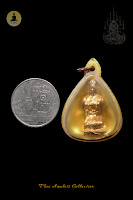Mae Nang Kwak Nur Khali Thong BE2517 Luang Pu Tim (Lp Tim) Wat Lahanrai
Mae Nang Kwak Nur Khali Thong – B.E. 2517 (1974)
Created by Luang Pu Tim of Wat Lahanrai, Rayong Province
A Sacred Talisman of Prosperity, Business Fortune, and Auspicious Blessings
1. Historical Background and Purpose of Creation
In B.E. 2517 (1974), the highly revered monk Luang Pu Tim Issarigo of Wat Lahanrai initiated the creation of the Mae Nang Kwak Nur Khali Thong amulet. This was one of the rarest and most purpose-driven batches crafted during his late years.
The primary purposes for creating this batch included:
-
To support local merchants and farmers who struggled with poverty and economic challenges, especially those in Rayong and the Eastern Seaboard who had strong faith in Luang Pu Tim.
-
To raise temple funds for expanding and renovating Wat Lahanrai’s facilities, including the construction of new monastic residences (kuti), Dhamma halls, and a school for monastic education.
-
To promote and preserve Buddhist devotion through folk beliefs, combining the popular figure of Nang Kwak with traditional sacred consecration methods.
-
To serve as a practical amulet for laypeople, especially women and market vendors, seeking blessings for financial improvement and household stability.
This batch was released quietly and in limited quantities, primarily distributed to devoted followers and temple supporters.
2. Materials and Sacred Composition
The Mae Nang Kwak amulet was produced in the Nur Khali Thong (reddish-bronze/copper alloy) variant—revered for its beauty and conductive spiritual properties.
Key materials used:
-
Thong Daeng (red brass/copper): Cast using traditional pouring methods during an auspicious hour.
-
Mixed with sacred powders previously used in Luang Pu Tim’s Phra Khun Paen and Phra Pidta batches, enhancing continuity of spiritual energy.
-
Inscriptions and base codes were added using hand-stamped temple markings, with some pieces individually numbered.
The figurine depicts Nang Kwak seated in traditional Thai attire with one arm raised in the iconic beckoning gesture—symbolizing the calling of wealth and customers.
3. Consecration and Ritual Blessings
The amulets were fully consecrated by Luang Pu Tim himself, during his late years, making this batch particularly meaningful to devotees.
The consecration included:
-
Private meditative empowerment sessions by Luang Pu Tim, who was known for his deep samādhi practice.
-
Prolonged chanting of sacred katha, especially metta and wealth-invoking mantras like “Katha Nang Kwak,” “Chinabanchon,” and “Itthipiso.”
-
Multi-day Phutthaphisek ceremony involving monks from neighboring temples who revered Luang Pu Tim as a spiritual elder.
The blessing ritual emphasized metta (loving-kindness) and utmost sincerity, with each amulet symbolizing a gift of goodwill for the lay community.
4. Spiritual Significance and Believed Benefits
The Mae Nang Kwak amulet is associated with powerful and well-rounded spiritual advantages:
| Category | Spiritual Benefit |
|---|---|
| Maha Lap | Attracts wealth, luck, and unexpected windfalls |
| Metta Mahaniyom | Improves likability, customer rapport, and public relations |
| Business Prosperity | Boosts sales, draws clients, and enhances commercial success |
| Household Stability | Brings harmony and abundance to homes and family businesses |
| Protection | Shields against misfortune and spiritual disturbances |
| Boon Baramee | Cultivates moral merit and spiritual grace in daily life |
This amulet became especially popular among vendors, restaurant owners, and businesspeople seeking to stabilize and grow their livelihoods during a time of national economic challenge.
5. Rarity and Collector Notes
-
Production volume was limited and not widely advertised; many pieces were directly given to close disciples or donors.
-
Some amulets bear temple stamp marks or casting codes, which aid in authentication.
-
Due to its direct consecration by Luang Pu Tim, this batch is highly collectible and revered by both investors and spiritual practitioners.
-
The surviving pieces often show signs of age-induced patina but are still prized for their spiritual energy.

%20Wat%20Lahanrai%20.png)
.png)
.png)


%20%E9%BE%99%E5%A9%86%E5%A4%9A%20%20Wat%20Pradoochimplee.png)
%20Pim%20Lek%20Fang%20Tarkut%20BE2523%20Nur%20Phong%20Kerson%20(108%20materials)%20Somdej%20Phra%20Yanasangwon%20(Charoen))%20Wat%20Bowonniwet%20Vihara%20blessed%20by%20Luang%20Pu%20Toh%20Wat%20Pradoochimplee%20(Grand%20ceremony).png)
%20Nur%20Phong%20Prai%20Kuman%20BE2545%20%20Luang%20Phor%20Yeam%20(Lp%20Yeam)%20Wat%20Sam%20Ngan%20%20.png)
%20%20Wat%20Khao%20Kaew,%20Nakhon%20Sawan%20Province%20(hand-inscribed%20with%20Yant%20behind)%20.png)
%20Wat%20Kositaram%20.png)
%20.png)
%20Wat%20Rai%20Taeng%20Thong,%20Nakhon%20Pathom%20Province.png)

%20Roon%20Lueng%20Samanasak%20Nur%20Thong%20Daeng%20BE2559%20Wat%20Tako%20Medallion%20for%20promotion%20of%20the%20ecclesiastical%20rank%20(code%20416).png)
%20BE2533%20Luang%20Phor%20Ruem%20Wat%20Chukkacher,%20Chonburi.png)
Comments
Post a Comment
Thank you for your comment. We will get back to you soon.